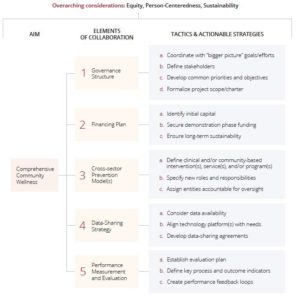
13 Jun Partnering to Catalyze Comprehensive Community Wellness
An Actionable Framework for Health Care and Public Health Collaboration
Health professionals working to protect and improve health in communities and across the nation realize that none of our distinct systems – not health care, public health, nor social services – is fully equipped to accomplish its mission alone. There is mounting recognition that to truly improve health outcomes in the U.S. and curb chronic diseases there must be an interdisciplinary, coordinated, and cross-sector approach to address acute conditions and the upstream social factors that contribute to poor health outcomes. This approach requires transformation of the way the health and human service systems traditionally interact.
In pursuit of this goal, members of the Public Health Leadership Forum (PHLF) and Health Care Transformation Task Force (HCTTF) developed a framework to help catalyze and facilitate collaborative working relationships between the public health and health care sectors. Such partnerships are an essential component of the “comprehensive community wellness approach,” one in which effective, collaborative relationships across sectors ensure more seamless care and prevention services for all. Under this approach, public health, health care, and social service and community organizations intentionally build high-functioning partnerships to address health needs in their communities, and invest in the time, staff, information platforms, and oversight structures needed to sustain them. The framework outlines essential elements of collaboration and presents key tactics and strategies for forming or reshaping effective partnerships.
The framework requires action from key stakeholders to realize the comprehensive community wellness vision:
- Public health and health care leaders can use the framework to convene collaborative groups, commit the time and resources needed to effectively collaborate on a shared vision, and grow a generation of health professionals who view multi-sector collaboration as the norm.
- Local, state, and federal policy makers can learn from the examples of effective cross-sector collaboration that informed development of the framework to advance policies and programs that create the catalysts and conditions in which collaborative wellness approaches thrive.
- Health practitioners can identify opportunities to engage and support community-based organizations in structured partnerships to ensure health interventions can truly take hold.
This practical tool was developed with the shared conviction that collaboration between public health and health care entities is a crucial, though not sufficient, step toward achieving comprehensive community wellness. We believe strong health care and public health partnerships can be the foundation around which a larger network of multi-sector allies working to improve community health can form.
Read the accompanying press release and blog in NEJM Catalyst.
Support for this project was provided in part by the Robert Wood Johnson Foundation. The views expressed here do not necessarily reflect the views of the Foundation.

